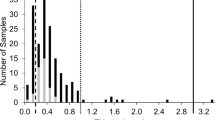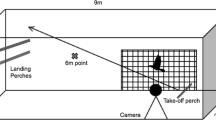Abstract
Mercury (Hg) adversely affects the health and behavior of exposed wildlife; however, behavioral effects remain largely unknown. Changes in avian singing behavior may affect a male’s fitness because song reveals male quality and thus influences female mate choice and male territory-holding ability. Nelson’s sparrows (Ammodramus nelsoni) live exclusively on salt marshes and risk high levels of Hg exposure and bioaccumulation. We recorded songs of male Nelson’s sparrows at two locations with different Hg exposure to determine if total blood Hg concentration was related to song characteristics, as previously reported for other species. Males with higher blood Hg levels sang at higher maximum tonal frequency, but blood Hg and site location did not influence low tonal frequency and bout duration, contrary to predictions based on other species. Within the contaminated site, Hg levels were related to bouts per minute and gap duration, such that males at that site sang faster songs. Hg influences hormones and alters brain development, raising questions about specific effects on the brains and singing behavior of male Nelson’s sparrows.

Similar content being viewed by others
References
Bank MS, Burgess JR, Evers DC, Loftin CS (2007) Mercury contamination of biota from Acadia National Park, Maine: a review. Environ Model Assess 126:105–115
Bermúdez-Cuamatzin E, Ríos-Chelén AA, Gil D, Garcia CM (2011) Experimental evidence for real-time song frequency shift in response to urban noise in a passerine bird. Biol Lett 7:36–38
Bischoff LL, Tschirren B, Richner H (2009) Long-term effects of early parasite exposure on song duration and singing strategy in Great Tits. Behav Ecol 20:265–270
Bodaly RA, Kopec AD, Rudd JWM, Fisher NS, Whipple CG (2009) Penobscot River Mercury Study: update to phase 1 report. Report to Judge John Woodcock US District Court (District of Maine), Bangor, Maine, pp 1–184
Bouton SN, Frederick PC, Spalding MG, McGill H (1999) Effects of chronic, low concentrations of dietary methylmercury on the behavior of juvenile Great Egrets. Environ Toxicol Chem 18:1934–1939
Buchanan KL, Spencer KA, Goldsmith AR, Catchpole CK (2003) Song as an honest signal of past developmental stress in the European Starling (Sturnus vulgaris). Proc Biol Sci 270:1149–1156
Buchanan KL, Leitner S, Spencer KA, Goldsmith AR, Catchpole CK (2004) Does song quality indicate early developmental stress? Horm Behav 46:128
Byers BE, Kroodsma DE (2009) Female mate choice and songbird song repertoires. Anim Behav 77:13–22
Clotfelter ED, Bell AM, Levering KR (2004) The role of animal behaviour in the study of endocrine-disrupting chemicals. Anim Behav 68:665–676
DiQuinzio DA, Paton PWC, Eddleman WR (2001) Site fidelity, philopatry and survival of promiscuous Saltmarsh Sharp-tailed Sparrows in Rhode Island. Auk 118:888–899
Driscoll CT, Han Y-J, Chen CY, Evers DC, Lambert KF, Holsen TM, Kamman NC, Munson RK (2007) Mercury contamination in forest and freshwater ecosystems in the northeastern United States. Bioscience 57:17–28
Eagles-Smith CA, Ackerman JT, De La Cruz SEW, Takekawa JY (2009) Mercury bioaccumulation and risk to three waterbird foraging guilds is influenced by foraging ecology and breeding stage. Environ Pollut 157:1993–2002
Evers DC, Han Y-J, Driscoll CT, Kamman NC, Goodale MW, Fallon Lambert K, Holsen TM, Chen CY, Clair TA, Butler T (2007) Biological mercury hotspots in the northeastern United States and southeastern Canada. Bioscience 57:29–43
Gorissen L, Snoeijs T, Van Duyse E, Eens M (2005) Heavy metal pollution affects dawn singing behaviour in a small passerine bird. Oecologia 145:504–509
Greenlaw JS (1993) Behavioral and morphological diversification in Sharp-tailed Sparrows (Ammodramus caudacutus) of the Atlantic Coast. Auk 110:286–303
Greenlaw JS, Rising JD (1994) Sharp-tailed sparrow. In: Poole A, Gill F (eds) The birds of North America, No. 112. The Academy of Natural Sciences, Philadelphia; The American Ornithologists’ Union, Washington, DC
Hallinger KK, Cristol DA (2011) The role of weather in mediating the effect of mercury exposure on reproductive success in tree swallows. Ecotoxicology 20:1368–1377
Hallinger KK, Zabransky DJ, Kazmer KA, Cristol DA (2010) Birdsong differs between mercury-polluted and reference sites. Auk 127:156–161
Hodgman TP, Shriver WG, Vickery PD (2002) Redefining range overlap between the Sharp-tailed Sparrows of coastal New England. Wilson Bull 114:38–43
Hoogesteijn AL, Kollias GV, Quimby FW, De Caprio AP, Winkler DW, DeVoogd TJ (2008) Development of a brain nucleus involved in song production in Zebra Finches (Taeniopygia guttata) is disrupted by aroclor 1248. Environ Toxicol Chem 27:2071–2075
Kroodsma DE, Wilda K, Salas V, Muradian R (2001) Song variations among Cistothorus Wrens, with a focus on Mérida Wren. Condor 103:855–861
Markman S, Leitner S, Catchpole C, Barnsley S, Muller CT, Pascoe D, Buchanan KL (2008) Pollutants increase song complexity and volume of the brain area HVC in a songbird. PLoS One 3:1–6
Marler P, Isaac D (1960) Physical analysis of a simple bird song as exemplified by the chipping sparrow. Condor 62:124–135
Nocera JJ, Fitzgerald TM, Hanson AR, Milton GR (2007) Differential habitat use by Acadian Nelson’s Sharp-tailed Sparrows: implication for regional conservation. J Field Ornithol 78:50–55
Nowicki S, Peters S, Podos J (1998) Song learning, early nutrition and sexual selection in songbirds. Am Zool 38:179–190
Nowicki S, Searcy WA, Peters S (2002) Brain development, song learning and mate choice in birds: a review and experimental test of the “nutritional stress hypothesis”. J Comp Physiol A 188:1003–1014
Podos J, Huber SK, Taft B (2004) Bird song: the interface of evolution and mechanism. Ann Rev Ecol Syst 35:55–87
Post W, Greenlaw JS (2006) Nestling diets of coexisting Salt Marsh Sparrows: opportunism in a food-rich environment. Estuar Coast 29:765–775
Rimmer CC, McFarland KP, Evers DC, Miller EK, Aubry Y, Busby D, Taylor RJ (2005) Mercury concentrations in Bicknell’s thrush and other insectivorous passerines in montane forests of Northeastern North America. Ecotoxicology 14:223–240
Searcy WA, Nowicki S, Hughes M, Peters S (2002) Geographic song discrimination in relation to dispersal in Song Sparrows. Am Nat 159:221–230
Shriver WG, Gibbs JP, Vickery PD, Gibbs HL, Hodgman TP, Jones PT, Jacques CN (2005) Concordance between morphological and molecular markers in assessing hybridization between Sharp-tailed Sparrows in New England. Auk 122:94–107
Shriver WG, Evers DC, Hodgman TP, MacCulloch BJ, Taylor RJ (2006) Mercury in Sharp-tailed Sparrows breeding in coastal wetlands. Environ Bioindic 1:129–135
Slabbekoorn H, Ripmeester EAP (2008) Birdsong and anthropogenic noise: implications and application for conservation. Mol Ecol 17:72–83
Slabbekoorn H, Smith TB (2002) Bird song, ecology and speciation. Philos Trans R Soc Lond B 357:493–503
Soha JA, Lohr B, Gill DE (2009) Song development in the grasshopper sparrow, Ammodramus savannarum. Anim Behav 77:1479–1489
Spencer KA, Buchanan KL, Goldsmith AR, Catchpole CK (2003) Song as an honest signal of developmental stress in the Zebra Finch (Taeniopygia guttata). Horm Behav 44:132–139
Thompson DR, Hamer KC, Furness RW (1991) Mercury accumulation in great skuas Catharacta skua of known age and sex, and its effects upon breeding and survival. J Appl Ecol 28:672–684
Wolfe MF, Schwarzbach S, Sulaiman RA (1998) Effects of mercury on wildlife: a comprehensive review. Environ Toxicol Chem 17:146–160
Zala SM, Penn DJ (2004) Abnormal behaviours induced by chemical pollution: a review of the evidence and new challenges. Anim Behav 68:649–664
Acknowledgments
We thank J. Walker and D. Evers for their advice and direction; staff at Biodiversity Research Institute, particularly O. Lane, for field assistance, analysis of blood Hg levels, and field housing; D. Cristol for comments on a previous draft; K. O’Brien and N. Pau for insight into the birds; and E. Adams, J. Atwood and K. Poulin for help with statistics. We also thank the National Park Service and B. Connery for use of their land and equipment, field housing, and knowledge; and the Maine Coast Heritage Trust, Tremont residents, and Maine Department of Inland Fisheries and Wildlife for permission to access their lands. Funding was provided by the University of Southern Maine’s Biology Department and Biodiversity Research Institute. All procedures were approved by the University of Southern Maine’s Institutional Animal Care and Use Committee (#03808-01) and comply with current Federal laws.
Author information
Authors and Affiliations
Corresponding author
Rights and permissions
About this article
Cite this article
McKay, J.L., Maher, C.R. Relationship between blood mercury levels and components of male song in Nelson’s sparrows (Ammodramus nelsoni). Ecotoxicology 21, 2391–2397 (2012). https://doi.org/10.1007/s10646-012-0994-0
Accepted:
Published:
Issue Date:
DOI: https://doi.org/10.1007/s10646-012-0994-0




